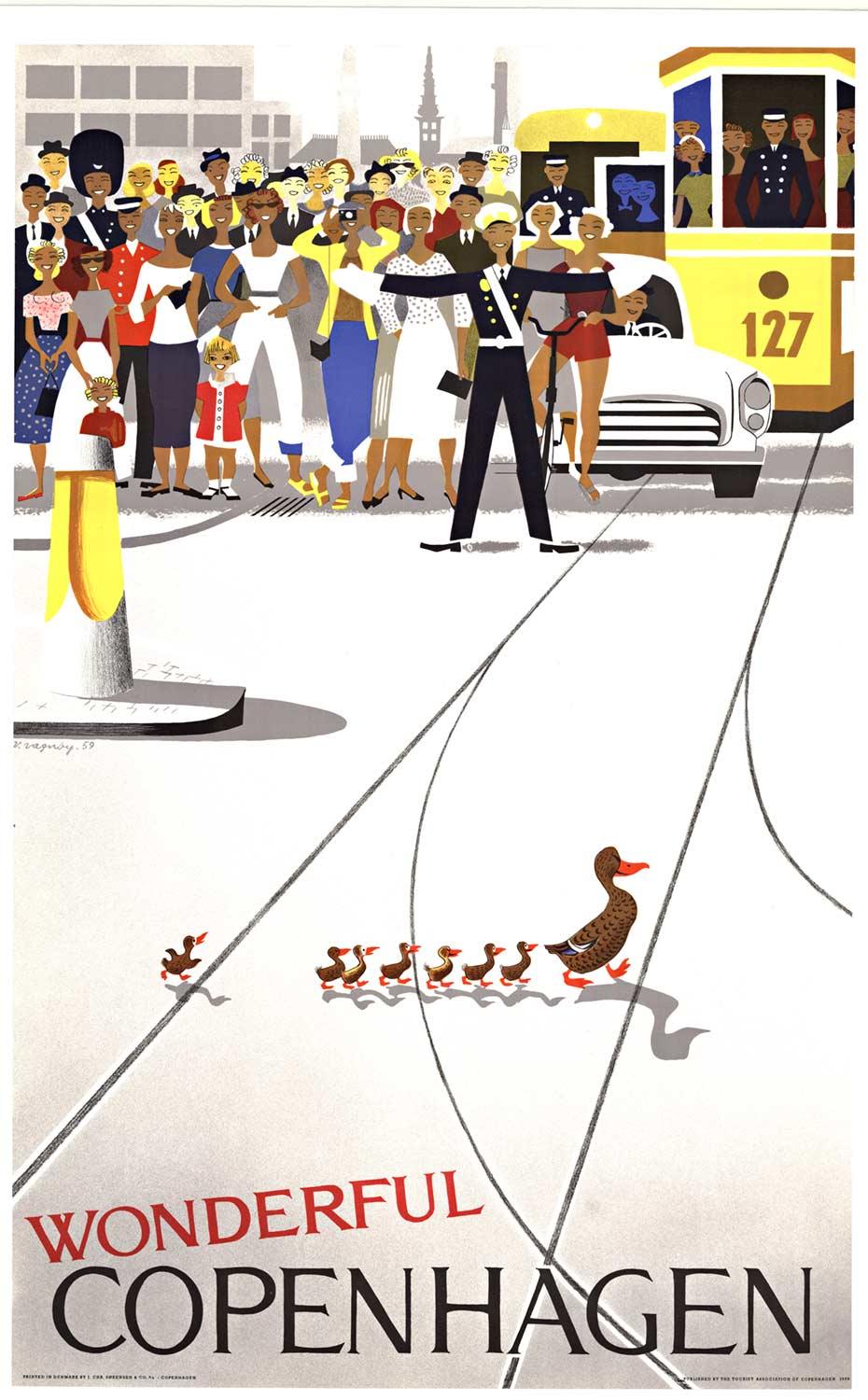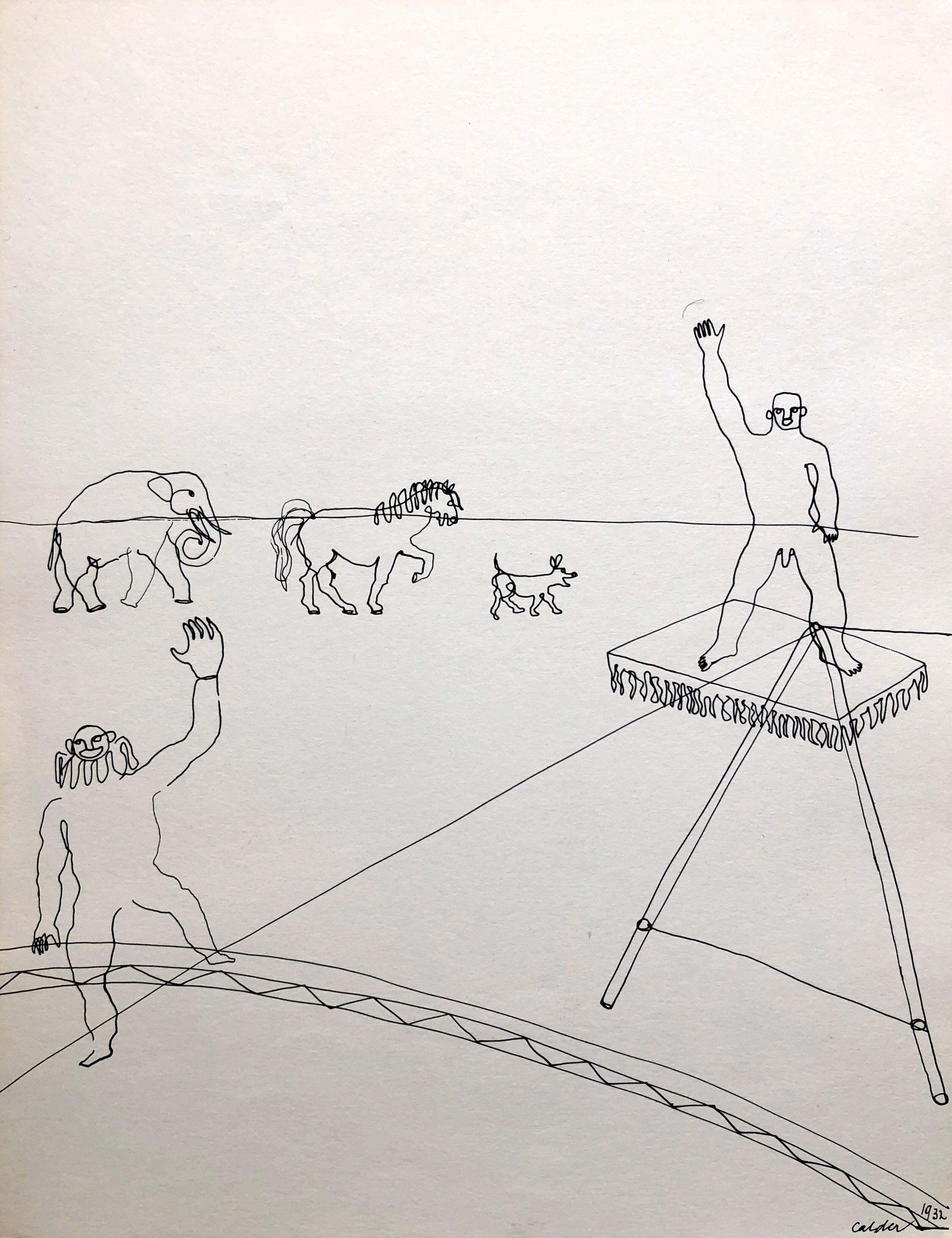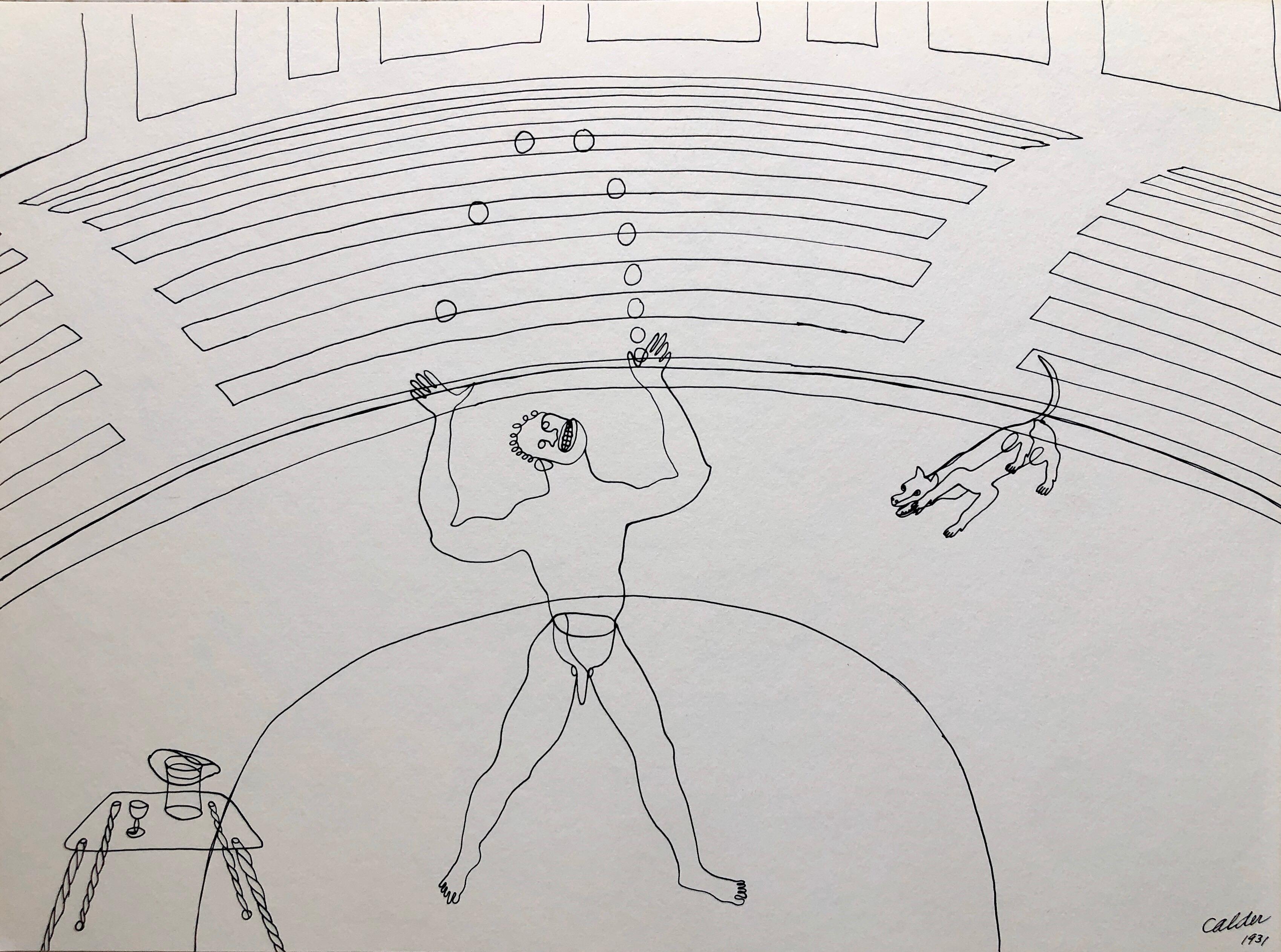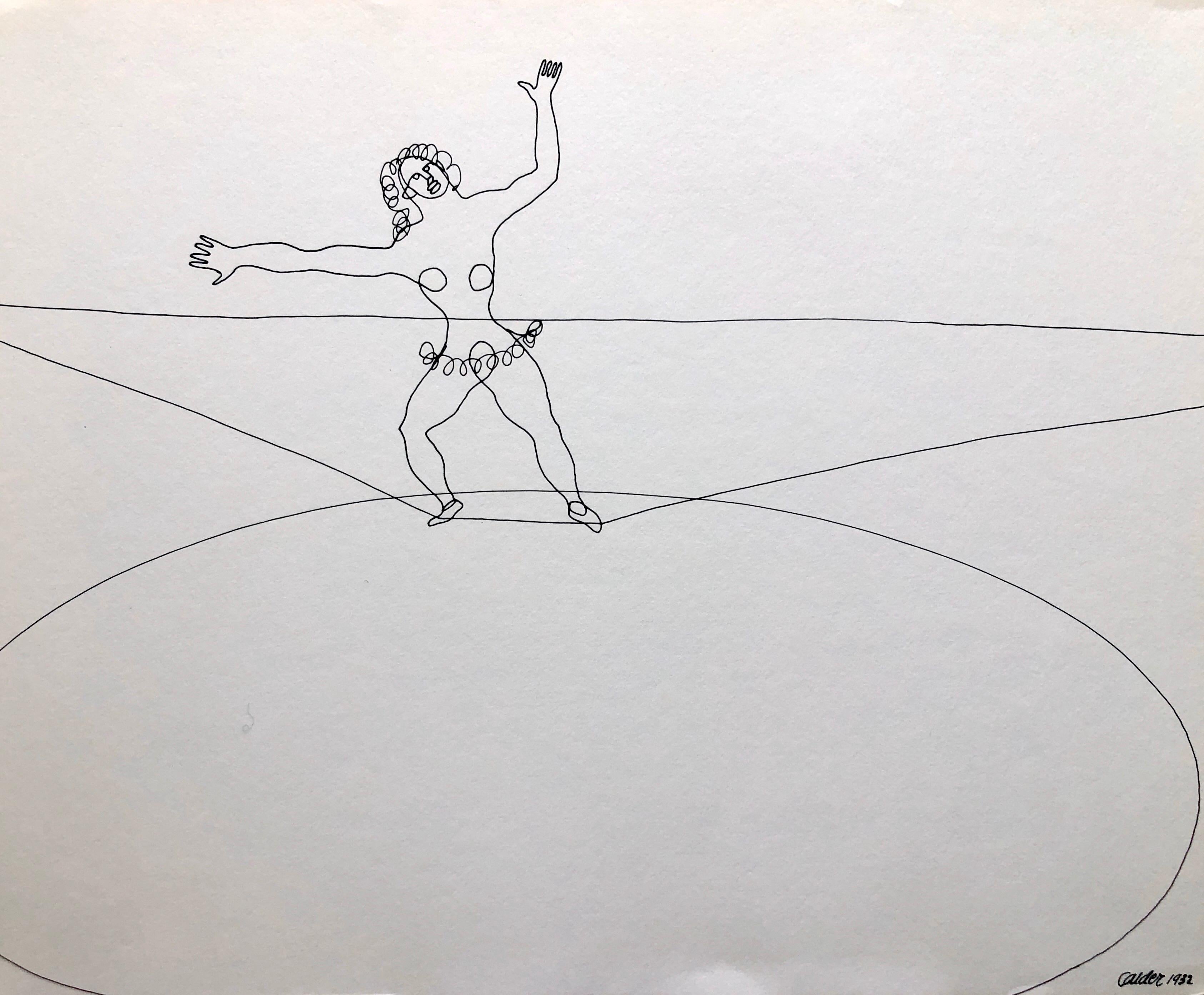Items Similar to 'Circular Motion' original lithograph signed by Georges Schreiber
Want more images or videos?
Request additional images or videos from the seller
1 of 8
Georges Schreiber'Circular Motion' original lithograph signed by Georges Schreiberca. 1936
ca. 1936
About the Item
In this lithograph, Georges Schreiber focused on the thrill of the circus, taking its circular composition from the central ring. Here, acrobats perform amazing feats of agility on the backs of a whorl of galloping horses. Schreiber made several prints of circus scenes, exemplifying the American zeitgeist for these traveling spectacles. When Schreiber came to the United States from his native Belgium, he started working in a regionalist style, and was especially influenced by Thomas Hart Benton in his images of American heartland. Insofar as his circus images show American pastimes, they fall in line with the larger themes of Regionalism, but at the same time they are divorced from Regionalism's gritty realism. Instead, these images show the circus as another world — as spaces where fantasy can offer a reprieve from the struggle of the Great Depression
10 x 13.5 inches, artwork
19 x 22 inches, frame
Signed in pencil, lower right
Published by the Associated American Artists
Framed to conservation standards using archival materials including 100 percent rag matting with a 1/4-inch bevel, Museum Glass, and a silver gilded moulding.
"I don't want to be just an American with citizenship papers," Schreiber declared. "I want to completely associate myself with America" (Current Biography, p. 674). Born in Brussels, Belgium in 1904, Schreiber did precisely that and, over the course of his career, became a thoroughly American artist.
Growing up in war-torn Europe, Schreiber was profoundly impacted by the horrors he witnessed. As a family of German descent living in Belgium during the First World War, the Schreibers were scorned by their neighbors; when they later returned to Germany, however, they were despised as Belgians. "All this has made me conscious of the times I live in . . . and the people I live with. It has made me strive with passion for human understanding in my work" (Current Biography, p. 673).
Young Schreiber studied art in Belgium, at the Academy of Fine Art in Berlin and in London; related travels took him to Paris, Rome and Florence. From 1925 to 1928, he worked as a free-lance artist for German newspapers, a line of work he would continue upon his arrival in American in 1928. By 1936, he was employed with the Works Project Administration.
An inveterate traveler, Schreiber visited each of the forty-eight states in 1939. The artist would ultimately make five cross-country journeys, from New England to California, Florida to Oregon, capturing contemporary American scenes with honesty and attention to detail. Considered en masse, Schreiber's oeuvre reveals the artist to be acutely aware of the world's brutal realities and keenly attuned to the characters he portrayed so powerfully.
Schreiber exhibited his travel paintings as a Panorama of America at numerous galleries and museums across the country. "Louisiana Cotton Pickers" was featured at the Whitney Gallery in 1939, along with another Louisiana subject. That same year, the artist was represented at the New York World's Fair. Preferring rural to urban themes, Schreiber's favorite composition was a lonely type set against a simple landscape background. "I want to live these people . . . not depict them" he said. (Current Biography, p. 675).
In addition to creating these heartfelt images, Schreiber continued to work as an illustrator. He sketched the Bruno Hauptmann kidnapping trial, illustrated the book "Little Man What Now", contributed to "Life" and "Fortune" magazines, and earned wide acclaim for his caricatures. A 1936 publication entitled "Portraits and Self-Portraits" contained illustrations with short biographies of famous contemporary figures, all executed by Schreiber.
During the Second World War, the United States Navy commissioned Schreiber to create paintings to use as posters. When fellow artists criticized him for this kind of work, Schreiber replied that "art for art's sake" should be shelved for the duration of the war and voiced his approval of any medium which brought good art to great numbers of people.
Over the course of his career, Georges Schreiber exhibited at the Metropolitan Museum of Art, Art Institute of Chicago, Whitney Gallery, White House Library, Library of Congress and Bibliotheque Nationale, among others. He garnered numerous awards, including the William Tuthill Prize. [Biography via. AskArt]
- Creator:Georges Schreiber (1904 - 1977, American)
- Creation Year:ca. 1936
- Dimensions:Height: 19 in (48.26 cm)Width: 22 in (55.88 cm)
- Medium:
- Movement & Style:
- Period:
- Condition:
- Gallery Location:Milwaukee, WI
- Reference Number:
About the Seller
4.9
Platinum Seller
These expertly vetted sellers are 1stDibs' most experienced sellers and are rated highest by our customers.
Established in 1966
1stDibs seller since 2017
391 sales on 1stDibs
Typical response time: 1 hour
- ShippingRetrieving quote...Ships From: Milwaukee, WI
- Return PolicyThis item cannot be returned.
More From This SellerView All
- 'The Rabbit' original woodcut engraving by Clarice George LoganBy Clarice George LoganLocated in Milwaukee, WIIn 'The Rabbit,' Wisconsin artist Clarice George Logan presents the viewer with a multi-figural scene: under a wood-frame structure, four children crouch on the ground, gathered around a young woman who presents a rabbit. Under normal circumstances, such an image of children with a bunny would recall childhood storybooks. In this case, however, the image is more ambiguous and suggests the unfortunate economic circumstances many children suffered during the interwar years. Nonetheless, the group could also be interpreted as a nativity play, with the rabbit taking the place of the Christ child, shining light on the children like in a painting by the Italian Renaissance artist Correggio. The careful line-work of the woodblock engraving adds a sense of expressionism to the scene, leaving the figures looking distraught and dirty, though the image nonetheless falls into the Social Realist category that dominated American artists during the Great Depression. This print was published in 1936 as part of the Wisconsin Artists' Calendar for the year 1937, which included 52 original, hand-made prints - one for each week of the year. Clarice George Logan was born in Mayville, New York in 1909 but moved to Wisconsin in 1921. She attended the Milwaukee State Teachers College from 1927 to 1931 where she studied with Robert von...Category
1930s American Modern Figurative Prints
MaterialsWoodcut, Engraving
- "Présure Guillien, Dijon Cow, " Original Color Lithograph Poster by L. SerreLocated in Milwaukee, WI"Présure Guillien, Dijon Cow" is an original color lithograph poster. The artist's name is printed in the lower left, and the name of the printing company, Havas, is printed in the lower right. The poster advertises rennet, a product used to curdle milk and make cheese, featuring a milk maid with a red kerchief tied around her head in front of a white cow. She holds a golden bucket...Category
1920s Modern Figurative Prints
MaterialsLithograph
- Original Lithograph Horse Anatomy Leonardo Davinci Nude Male Figure Sepia SignedBy Claude WeisbuchLocated in Milwaukee, WI"Homage a Leonardo d'Vinci (Leonardo drawing, 3 Figures, Horse from De La Bataille Vol. I)" is an original color lithograph signed by Claude Weisbuch. A group of figures stand to the...Category
1970s Modern Figurative Prints
MaterialsPaper, Lithograph
- "Two Horses from Homage to Marino Marini, " an Original signed by Marino MariniBy Marino MariniLocated in Milwaukee, WI"Two Horses from Homage to Marino Marini" is an original color lithograph signed in stone by Marino Marini. It depicts a horse and rider in abstracted contour lines and black shapes ...Category
1970s Post-Modern Animal Prints
MaterialsLithograph
- 'Le Condottiere' original signed lithograph poster, knight on horseback 1970sBy Claude WeisbuchLocated in Milwaukee, WIThis poster, produced for the 1978 International Meeting of Fine Art Dealers in Washington, features prominently one of Claude Weisbuch's dynamic images: Le Condottiere. It is an original color lithograph advertising his new works, and is one of only twenty-five that bears the artist's signature in the lower right. In line with Weisbuch's interest in the Renaissance and Baroque in Europe, this image looks back to the early modern period. Condottieri were Italian captains...Category
1970s Contemporary Figurative Prints
MaterialsLithograph
- 'Boeuf Ecorche' original signed lithograph, Rembrandt with slaughtered ox 1970sBy Claude WeisbuchLocated in Milwaukee, WI'Boeuf Ecorche' is an original color lithograph, signed by Claude Weisbuch – and it is a quintessential example of the contemporary artist's interest in the old masters. In the image...Category
1970s Contemporary Figurative Prints
MaterialsLithograph
You May Also Like
- Original "Wonderful Copenhagen" vintage travel posterLocated in Spokane, WAOriginal vintage poster: WONDERFUL COPENHAGEN created by the artist Viggo Vagnby. This antique poster is archival linen backed, in excellent co...Category
1950s American Modern Animal Prints
MaterialsLithograph
- Alexander Calder Circus Reproduction Lithograph After a DrawingBy (after) Alexander CalderLocated in Surfside, FL(after) Alexander Calder "Calder's Circus" offset lithograph on wove paper after drawings by the artist Published by Art in America and Perls gallery in 1964 (from drawings done in the 1930's) these range slightly in size but they are all about 13 X 17 inches (with minor variations in size as issued.) These have never been framed. The outer folio is not included just the one lithograph. James Sweeny from the introduction “The fame of Calder’s circus spread quickly between the years 1927 and 1930. All the Paris art world came to know it. It brought him his first great personal success. But what was more important, the circus also provided the first steps in Calder’s development as an original sculptor” Clive Gray...Category
1930s American Modern Animal Prints
MaterialsLithograph
- Alexander Calder Circus Reproduction Lithograph After a DrawingBy (after) Alexander CalderLocated in Surfside, FL(after) Alexander Calder "Calder's Circus" offset lithograph on wove paper after drawings by the artist Published by Art in America and Perls gallery in 1964 (from drawings done in the 1930's) these range slightly in size but they are all about 13 X 17 inches (with minor variations in size as issued.) These have never been framed. The outer folio is not included just the one lithograph. James Sweeny from the introduction “The fame of Calder’s circus spread quickly between the years 1927 and 1930. All the Paris art world came to know it. It brought him his first great personal success. But what was more important, the circus also provided the first steps in Calder’s development as an original sculptor” Clive Gray...Category
1930s American Modern Animal Prints
MaterialsLithograph
- Alexander Calder Circus Reproduction Lithograph of a DrawingBy (after) Alexander CalderLocated in Surfside, FL(after) Alexander Calder "Calder's Circus" offset lithograph on wove paper a reproduction lithograph after the drawings by the artist Published by Art in America and Perls gallery in 1964 (from drawings done in the 1930's) these range slightly in size but they are all about 13 X 17 inches (with minor variations in size as issued.) These have never been framed. The outer folio is not included just the one lithograph. James Sweeny from the introduction “The fame of Calder’s circus spread quickly between the years 1927 and 1930. All the Paris art world came to know it. It brought him his first great personal success. But what was more important, the circus also provided the first steps in Calder’s development as an original sculptor” Clive Gray...Category
1930s American Modern Animal Prints
MaterialsLithograph
- Alexander Calder Circus Reproduction Lithograph After a DrawingBy (after) Alexander CalderLocated in Surfside, FL(after) Alexander Calder "Calder's Circus" offset lithograph on wove paper after drawings by the artist Published by Art in America and Perls gallery in 1964 (from drawings done in the 1930's) these range slightly in size but they are all about 13 X 17 inches (with minor variations in size as issued.) These have never been framed. The outer folio is not included just the one lithograph. James Sweeny from the introduction “The fame of Calder’s circus spread quickly between the years 1927 and 1930. All the Paris art world came to know it. It brought him his first great personal success. But what was more important, the circus also provided the first steps in Calder’s development as an original sculptor” Clive Gray...Category
1930s American Modern Animal Prints
MaterialsLithograph
- Bareback Act, Old HippodromeBy Gifford BealLocated in Missouri, MOBareback Act, Old Hippodrome By Gifford Beal (1879-1956) Signed Lower Right Unframed: 6.5" x 9.5" Framed: 17.5" x 20" Gifford Beal, painter, etcher, muralist, and teacher, was born in New York City in 1879. The son of landscape painter William Reynolds Beal, Gifford Beal began studying at William Merritt Chase's Shinnecock School of Art (the first established school of plein air painting in America) at the age of thirteen, when he accompanied his older brother, Reynolds, to summer classes. He remained a pupil of Chase's for ten years also studying with him in New York City at the artist's private studio in the Tenth Street Studio Building. Later at his father's behest, he attended Princeton University from 1896 to 1900 while still continuing his lessons with Chase. Upon graduation from Princeton he took classes at the Art Students' League, studying with impressionist landscape painter Henry Ward Ranger and Boston academic painter Frank Vincent DuMond. He ended up as President of the Art Students League for fourteen years, "a distinction unsurpassed by any other artist." His student days were spent entirely in this country. "Given the opportunity to visit Paris en route to England in 1908, he chose to avoid it" he stated, "I didn't trust myself with the delightful life in ParisIt all sounded so fascinating and easy and loose." His subjects were predominately American, and it has been said stylistically "his art is completely American." Gifford achieved early recognition in the New York Art World. He became an associate member of the National Academy of Design in 1908 and was elected to full status of academician in 1914. He was known for garden parties, circuses, landscapes, streets, coasts, flowers and marines. This diversity in subject matter created "no typical or characteristic style to his work." Beal's style was highly influenced by Chase and Childe Hassam, a long time friend of the Beal family who used to travel "about the countryside with Beal in a car sketching...Category
20th Century American Modern Animal Prints
MaterialsLithograph
Recently Viewed
View AllMore Ways To Browse
George Back
Large Vintage Signs Original
George 1
Original Lithographs Large
Signed Large Lithographs
George Short
Signed Lithograph Sets
Vintage Florida Signs
Vintage Florida Sign
Original Lithographs European
Vintage Cotton Sign
American Vintage Belgium
Berlin Lithograph
Multiples Native American
Large Lithograph Set
Native American Warror
Modern Magazine Original Illustration
Native American War Art





